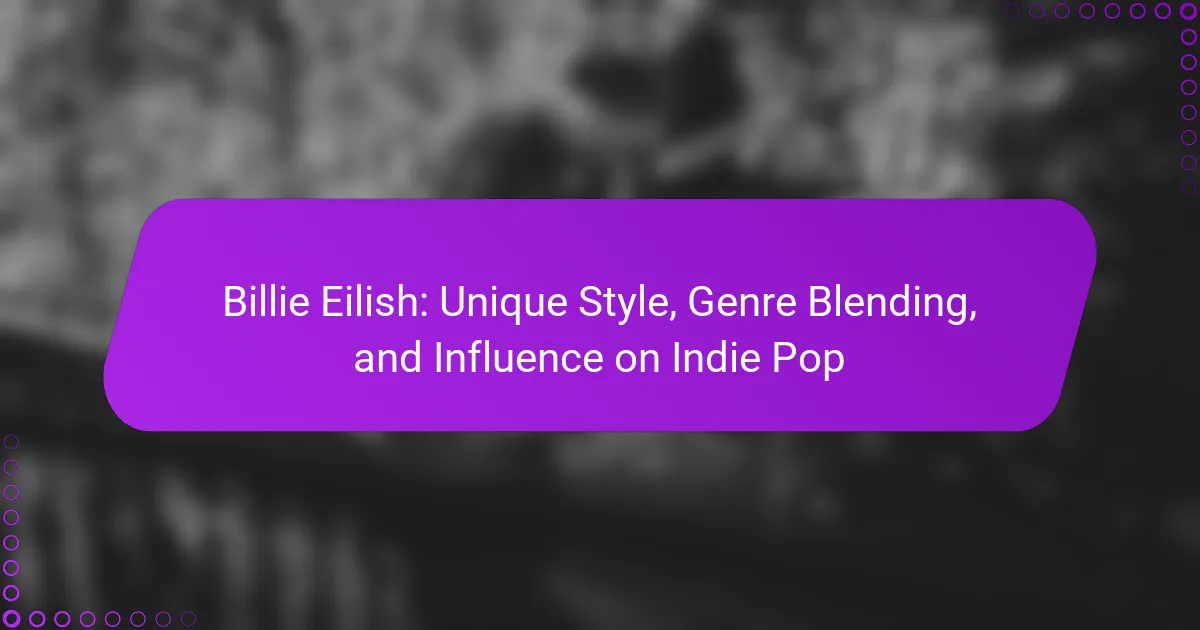Billie Eilish has transformed the indie pop landscape with her genre-blending music and unique style. This article explores her innovative sound, characterized by soft vocals and dark beats, her bold fashion choices that challenge beauty norms, and her significant influence on emerging artists. Additionally, we will examine her evolution from an indie sensation to a mainstream cultural icon and the misconceptions surrounding her artistry.
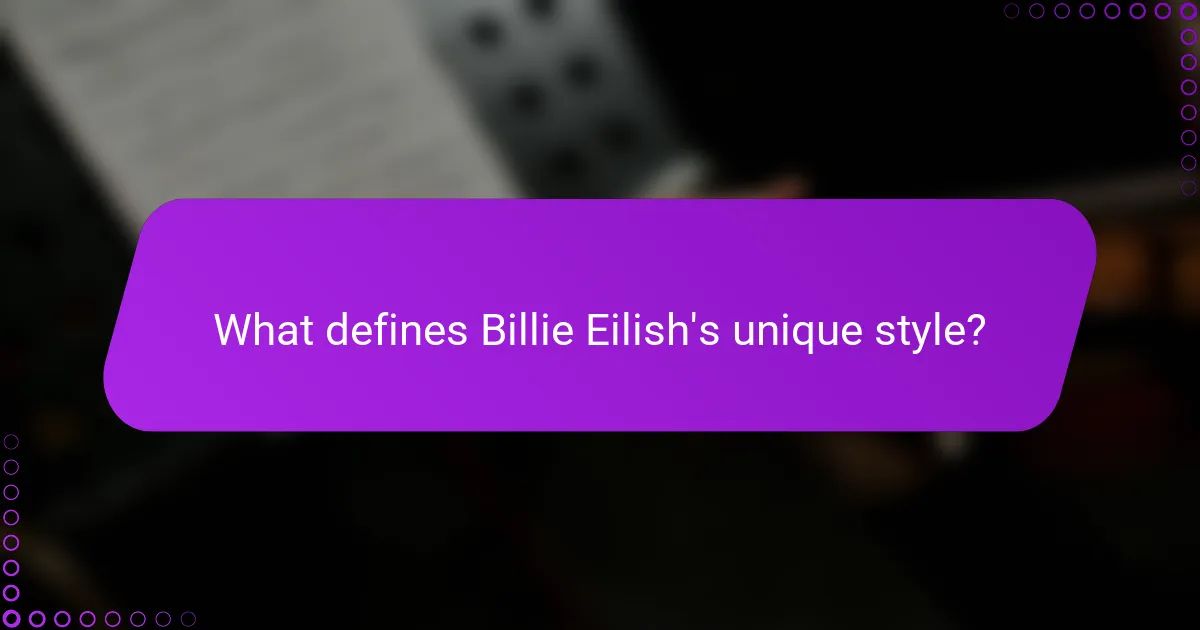
What defines Billie Eilish’s unique style?
Billie Eilish’s unique style is defined by her genre-blending approach, bold fashion choices, and emotional authenticity. Her music combines elements of pop, electronic, and indie genres, creating a distinct sound. Eilish’s fashion often features oversized clothing, which challenges traditional beauty standards and emphasizes comfort. This aesthetic reflects her individuality and resonates with her audience, making her a significant influence in indie pop culture.
How do Billie Eilish’s fashion choices reflect her artistic identity?
Billie Eilish’s fashion choices vividly reflect her artistic identity through bold, oversized silhouettes and vibrant colors. Her style embodies individuality and defies conventional norms, aligning with her genre-blending music. Eilish often utilizes fashion as a form of self-expression, challenging gender stereotypes and societal expectations. This unique approach has influenced the indie pop scene, inspiring fans and artists alike to embrace authenticity in their own styles.
What role do colors and textures play in her visual presentation?
Colors and textures significantly enhance Billie Eilish’s visual presentation by reflecting her unique style. Her use of bold colors, such as neon greens and deep blacks, creates a striking contrast that captures attention. Textures, like oversized clothing and layered fabrics, add depth and dimension to her look. This combination reinforces her identity as a genre-blending artist and resonates with her indie pop influence. Eilish’s visual choices often evoke emotions and convey messages, making her style an integral part of her artistic expression.
Which cultural influences shape her aesthetic?
Billie Eilish’s aesthetic is shaped by diverse cultural influences, including goth, punk, and streetwear. Her unique style merges these elements, creating a distinct visual identity. Eilish often incorporates oversized clothing, vibrant colors, and bold graphics, reflecting her individuality and rebellion against conventional norms. Additionally, her inspirations from music icons and contemporary art contribute to her innovative approach in the indie pop genre.
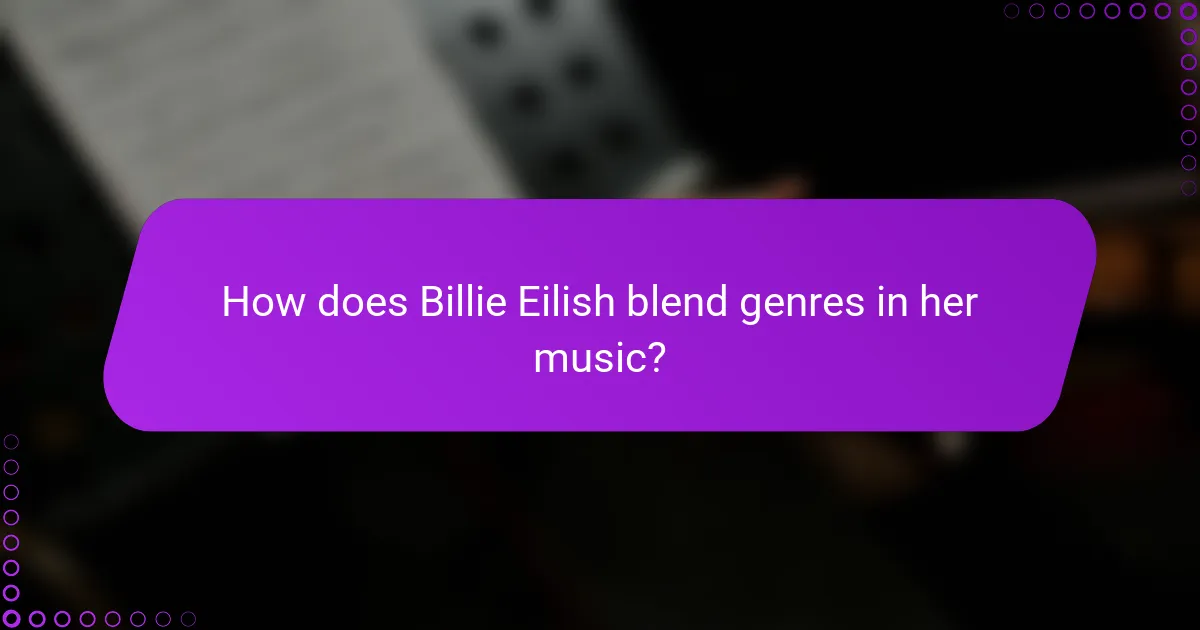
How does Billie Eilish blend genres in her music?
Billie Eilish blends genres by incorporating elements of pop, electronic, and alternative music into her unique sound. Her innovative approach combines soft vocals with dark, atmospheric beats, creating an emotional depth that resonates with listeners. Eilish often collaborates with her brother Finneas, who contributes to the genre-defying production. This partnership allows for experimentation with various musical styles, resulting in a distinctive indie pop influence that sets her apart. Eilish’s ability to seamlessly shift between genres reflects her artistic versatility and has significantly impacted contemporary music.
What genres does Billie Eilish incorporate into her sound?
Billie Eilish incorporates genres like pop, electropop, indie pop, and alternative. Her sound uniquely blends these styles, creating a distinct atmosphere. Eilish often integrates elements of hip-hop and R&B, showcasing her versatility. This genre fusion contributes significantly to her influence on contemporary music.
How does her genre blending appeal to diverse audiences?
Billie Eilish’s genre blending attracts diverse audiences by merging pop, electronic, and indie influences. This unique style creates a relatable and fresh sound that resonates across age groups. Her ability to incorporate varied musical elements allows listeners from different backgrounds to connect emotionally. For example, her haunting melodies and introspective lyrics appeal to those seeking depth, while catchy hooks draw in mainstream pop fans. This versatility enhances her reach and influence, solidifying her status in the indie pop scene.
Which collaborations highlight her genre-defying approach?
Billie Eilish’s collaborations with artists like Khalid and Justin Bieber showcase her genre-defying approach. These partnerships blend pop, R&B, and electronic influences, enhancing her unique sound. Eilish’s work with Finneas, her brother and primary collaborator, further exemplifies her innovative style. Each collaboration expands her artistic reach while maintaining her signature aesthetic.
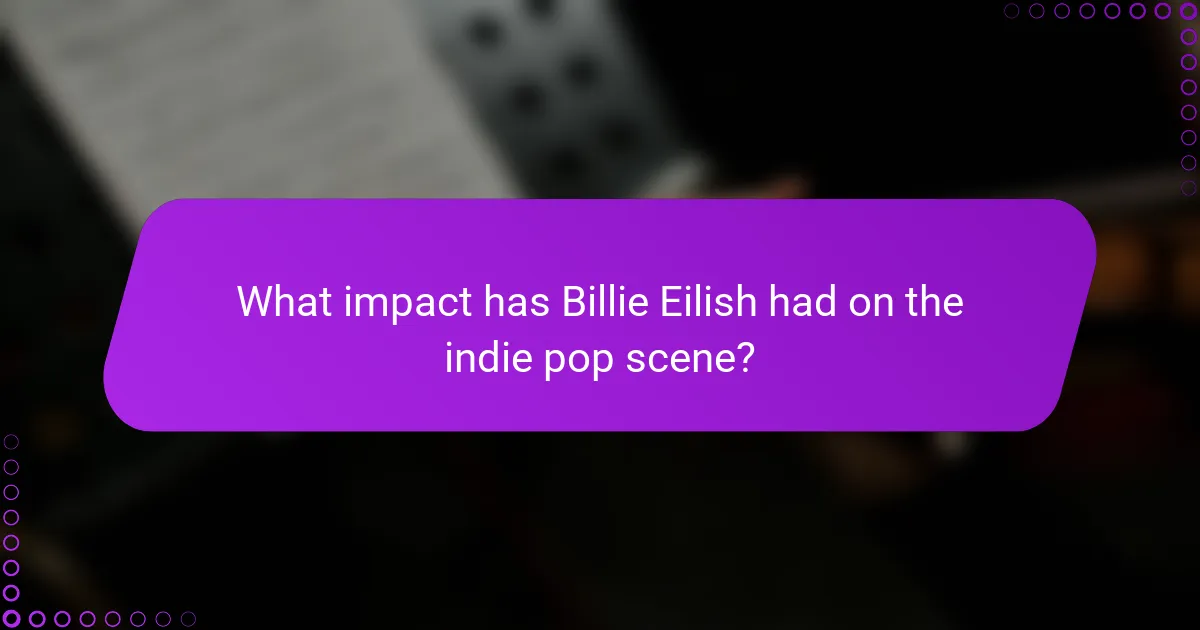
What impact has Billie Eilish had on the indie pop scene?
Billie Eilish has significantly influenced the indie pop scene through her unique style and genre-blending music. Her distinctive sound combines elements of pop, electronic, and alternative music, appealing to a diverse audience. Eilish’s introspective lyrics and unconventional production techniques have inspired many emerging artists to explore authenticity and emotional depth in their work. As a result, she has reshaped the expectations of what indie pop can encompass, encouraging a more experimental approach within the genre. Her impact is evident in the rise of artists who emulate her blending of styles and personal storytelling.
How has her music influenced emerging indie artists?
Billie Eilish’s music has significantly influenced emerging indie artists by promoting genre blending and authenticity. Her unique style encourages artists to explore diverse sounds and emotional vulnerability. Eilish’s success demonstrates that breaking traditional music norms can lead to widespread acceptance. As a result, many indie musicians are inspired to experiment with their artistry, embracing individuality over commercial expectations.
What themes in her lyrics resonate with indie pop fans?
Billie Eilish’s lyrics resonate with indie pop fans through themes of vulnerability, introspection, and emotional authenticity. Her exploration of mental health, relationships, and self-identity connects deeply with listeners. Unique attributes like her candid storytelling and genre-blending sound enhance her appeal, creating a relatable and immersive experience. As a result, fans appreciate her ability to articulate complex feelings in a raw and accessible manner.
Which awards and recognitions has she received in the indie genre?
Billie Eilish has received several prestigious awards in the indie genre, including multiple Grammy Awards and American Music Awards. Notably, she won the Grammy for Album of the Year for “When We All Fall Asleep, Where Do We Go?” in 2020. Her unique style and genre-blending have significantly influenced the indie pop landscape. She has also been recognized with accolades such as the MTV Video Music Awards for Best New Artist and Best Song. These honors highlight her impact and recognition within the indie music community.
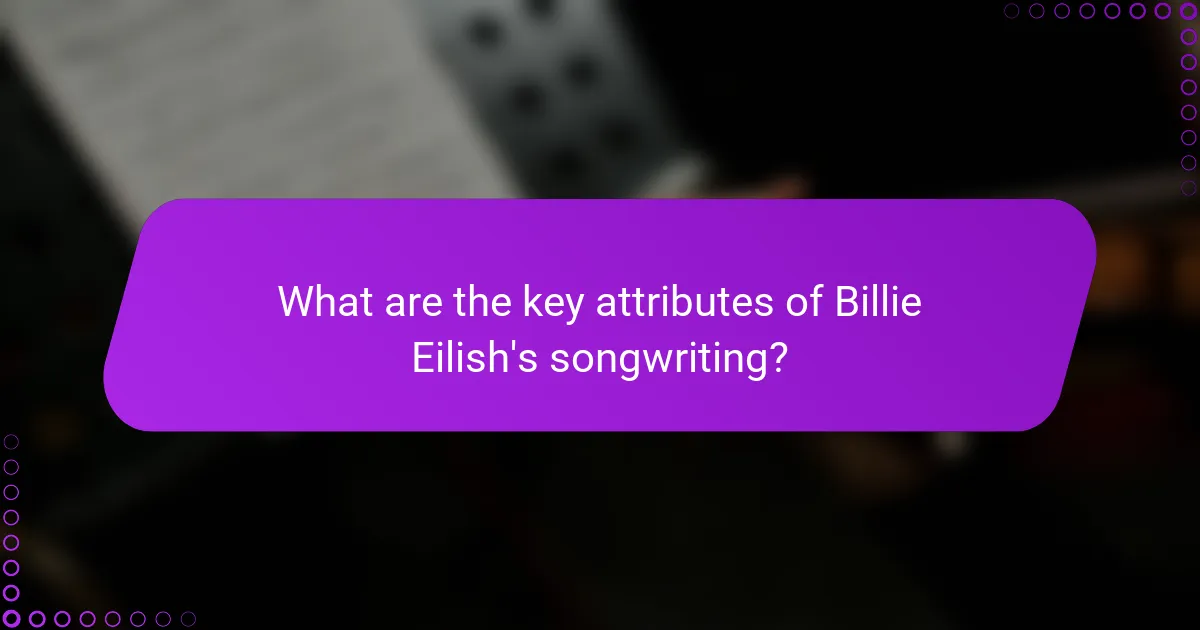
What are the key attributes of Billie Eilish’s songwriting?
Billie Eilish’s songwriting features introspective lyrics, minimalist production, and genre-blending elements. Her unique style often incorporates dark themes and personal narratives, enhancing emotional depth. Eilish frequently collaborates with her brother Finneas, contributing to her distinctive sound. This innovative approach has significantly influenced the indie pop genre, setting new trends.
How does she convey emotions through her lyrics?
Billie Eilish conveys emotions through her lyrics by using vivid imagery and personal storytelling. Her unique style blends raw vulnerability with haunting melodies, allowing listeners to connect deeply. Eilish often explores themes of anxiety, love, and self-identity, which resonate with her audience. The emotional depth in her lyrics, paired with minimalist production, enhances the overall impact, making her music relatable and poignant.
What storytelling techniques are prevalent in her songs?
Billie Eilish employs vivid imagery, emotional vulnerability, and conversational storytelling in her songs. These techniques create a relatable and immersive experience for listeners. Her use of personal narratives often reflects unique attributes, such as mental health themes and introspection, which resonate deeply with her audience. Additionally, she blends genres, enhancing the storytelling through diverse musical elements, making her songs stand out in the indie pop landscape.
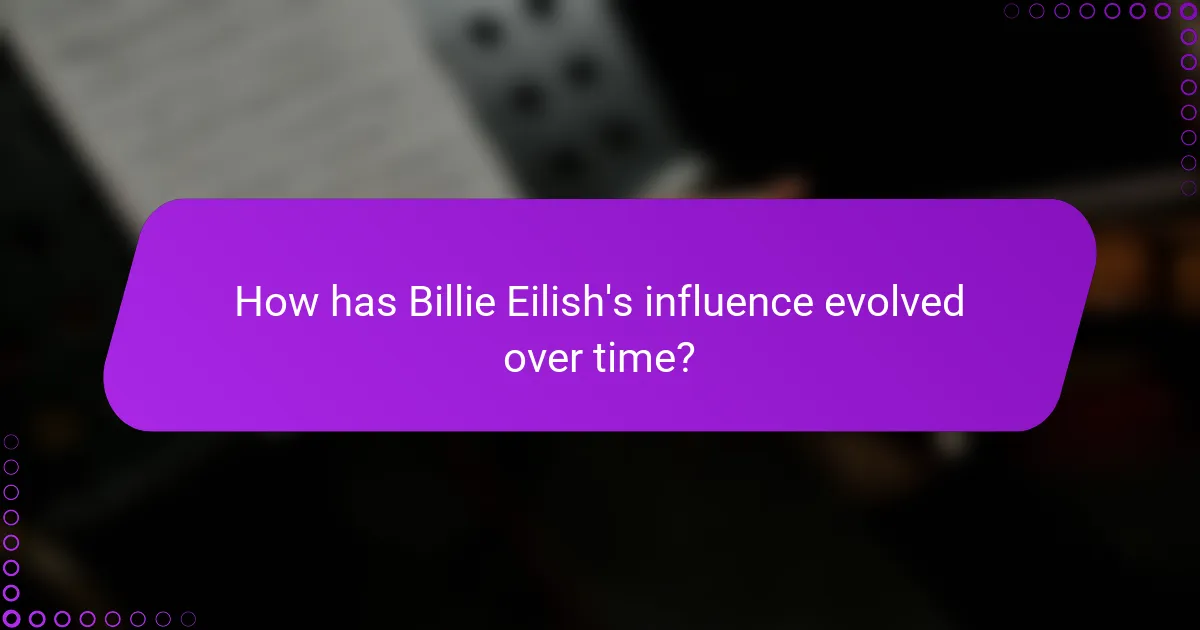
How has Billie Eilish’s influence evolved over time?
Billie Eilish’s influence has evolved significantly, shifting from a breakout indie pop artist to a mainstream cultural icon. Her unique style, characterized by oversized clothing and distinct visuals, has inspired a new generation of musicians and fashion enthusiasts.
Initially, Eilish gained attention with her haunting melodies and introspective lyrics, blending genres like pop, electronic, and alternative. This genre-blending approach has redefined indie pop, making it more accessible to diverse audiences. As a result, her music resonates with themes of mental health and self-identity, further amplifying her impact.
Over time, Eilish has leveraged her platform for social issues, advocating for climate change and mental health awareness. This activism has solidified her role not just as a musician but as a voice for her generation. Her collaborations with other artists and participation in high-profile events have expanded her reach, influencing both the music industry and popular culture at large.
Which milestones mark her growth as an artist?
Billie Eilish’s growth as an artist is marked by several key milestones. Her debut single “Ocean Eyes” launched her career in 2015, showcasing her unique style and vocal talent. The release of her album “When We All Fall Asleep, Where Do We Go?” in 2019 solidified her influence in indie pop, earning multiple Grammy Awards. Collaborations with artists like Khalid and Justin Bieber further expanded her reach and genre-blending capabilities. Her innovative music videos and distinct fashion choices have set trends, making her a cultural icon. Each milestone reflects her evolution and impact on the music industry.
How do her early works compare to her recent releases?
Billie Eilish’s early works feature a raw, minimalist sound, while her recent releases showcase more complex production and genre experimentation. Her debut EP, “Don’t Smile at Me,” emphasized intimate themes and lo-fi aesthetics. In contrast, her latest album, “Happier Than Ever,” incorporates a broader range of influences, including jazz and pop, reflecting her growth as an artist. This evolution highlights her unique ability to blend genres while maintaining a distinct voice in indie pop.
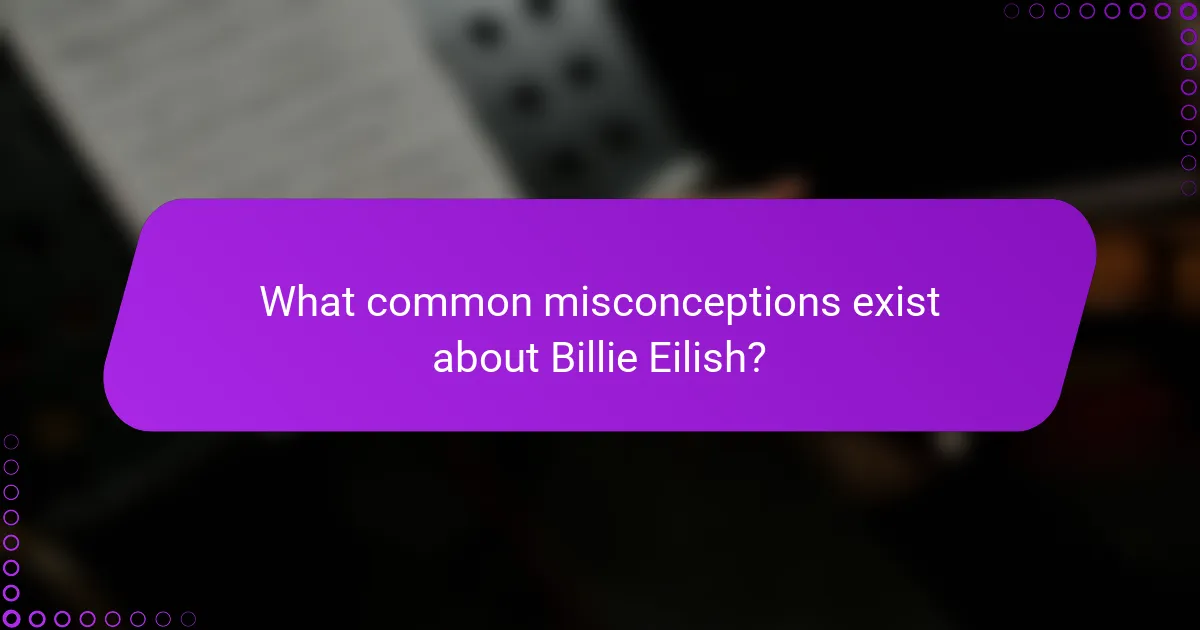
What common misconceptions exist about Billie Eilish?
Many misconceptions about Billie Eilish stem from her unique style and genre-blending music. Some believe her dark aesthetic reflects a negative mindset, while in reality, it symbolizes empowerment and authenticity. Others assume her success is solely due to her brother’s influence, overlooking her own songwriting talent and vocal abilities. Additionally, some critics claim her music lacks depth, but her lyrics often explore complex emotions and social issues, showcasing her artistic maturity. These misconceptions highlight the challenges of understanding an artist who defies conventional norms in the music industry.
How do public perceptions differ from her actual persona?
Public perceptions of Billie Eilish often contrast with her actual persona, which is more complex and grounded. While many view her as a rebellious figure, she emphasizes vulnerability and authenticity in her music. Eilish’s unique style blends various genres, showcasing her artistic versatility beyond mere indie pop. Furthermore, her influence extends to promoting mental health awareness, a facet often overlooked in public narratives.
What myths have been debunked about her career?
Several myths about Billie Eilish’s career have been debunked. One common misconception is that her music lacks depth; critics have noted her intricate lyrics and emotional resonance. Another myth is that she only appeals to a young audience; her fan base spans multiple age groups. Additionally, some believe her success is solely due to her unique style, but her genre-blending and songwriting skills are significant factors. Lastly, the idea that she does not collaborate with others is inaccurate, as she has worked with various artists and producers throughout her career.
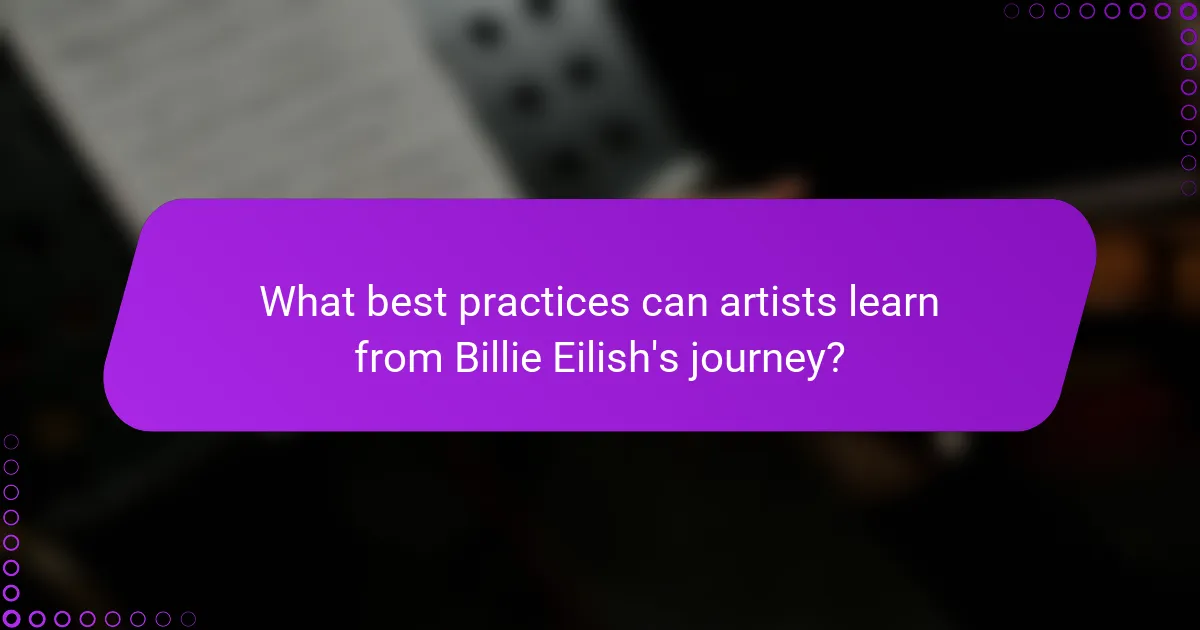
What best practices can artists learn from Billie Eilish’s journey?
Artists can learn several best practices from Billie Eilish’s journey. First, embrace authenticity by staying true to personal style and vision. Second, experiment with genre blending to create unique soundscapes that resonate with diverse audiences. Third, utilize innovative marketing strategies, such as engaging social media presence, to connect with fans. Lastly, prioritize mental health and self-care, as Eilish emphasizes the importance of balance in a demanding industry. These practices can help artists cultivate a distinct identity and foster lasting connections with their audience.
How can emerging artists develop their unique style?
Emerging artists can develop their unique style by experimenting with diverse influences and staying true to their artistic vision. Billie Eilish exemplifies this approach through her genre-blending sound and distinctive aesthetic.
Artists should explore various musical genres and incorporate elements that resonate with them. Eilish’s fusion of pop, electronic, and indie influences showcases how blending styles can create something fresh and authentic.
Additionally, personal storytelling plays a crucial role in defining an artist’s unique style. Eilish’s lyrics often reflect her experiences and emotions, making her music relatable and impactful.
Finally, embracing individuality and authenticity is essential. Artists should not shy away from expressing their true selves and should take inspiration from their surroundings, as Eilish does through her visuals and themes.
What strategies can be employed to blend genres effectively?
To blend genres effectively, artists can experiment with different musical styles, collaborate across genres, and incorporate diverse influences. Billie Eilish exemplifies this by merging pop, electronic, and indie elements, creating a unique sound that resonates widely.
Using contrasting rhythms and melodies can enhance the genre-blending process. For instance, Eilish often combines soft vocals with heavy beats, creating a distinctive auditory experience. Additionally, leveraging storytelling in lyrics can unify disparate genres, allowing for a cohesive narrative that engages listeners.
Exploring unconventional song structures can also facilitate genre fusion. Eilish frequently deviates from traditional verse-chorus patterns, which allows her to integrate various influences seamlessly. By embracing authenticity and personal expression, artists can create innovative genre blends that reflect their unique identities.
In summary, successful genre blending involves experimentation, collaboration, and a willingness to break conventions, as demonstrated by Billie Eilish’s influence on indie pop.
Which lessons from her career can guide future success in indie pop?
Billie Eilish’s career offers key lessons for indie pop success. Embrace authenticity, prioritize unique style, and blend genres to create a distinctive sound.
1. Authenticity is crucial; Eilish’s genuine expression resonates with fans.
2. A unique style sets artists apart; her visual and musical identity is iconic.
3. Genre blending expands audience reach; Eilish combines pop, electronic, and alternative influences.
4. Innovation attracts attention; her experimental approach challenges industry norms.
5. Strong storytelling connects emotionally; lyrics often reflect personal experiences and societal issues.
6. Building a loyal fanbase through social media fosters community engagement.
